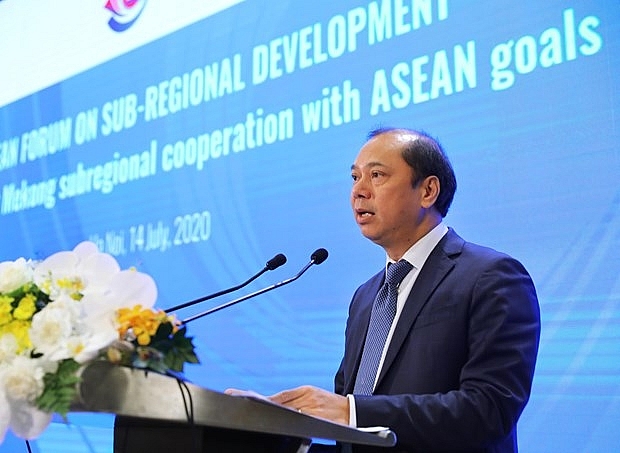ASEAN looks to boost sub-regional development
 |
| Deputy Minister of Foreign Affairs Nguyen Quoc Dung, head of the SOM ASEAN Vietnam (Photo: VNA) |
Hanoi – The Association of Southeast Asian Nations (ASEAN) is emerging and playing a central role in the region, thus looking to converge Mekong sub-regional cooperation with its development goals, according to Deputy Minister of Foreign Affairs Nguyen Quoc Dung, head of the SOM ASEAN Vietnam.
The ASEAN Forum on sub-regional development held in Hanoi on July 14 was the first activity of the bloc to discuss measures to create harmony and connect the Mekong sub-regional cooperation programmes with ASEAN and other sub-regions, thus contributing to the common goal of narrowing development gaps in ASEAN and building a strong ASEAN Community, he said.
Raising some solutions to promote coordination and connectivity among economic corridors of ASEAN’s sub-regions, Dung said the involved parties should work together to devise policies and mechanisms to address border gate issues.
ASEAN has reached agreements on border crossing among member countries, but each needs to concretise them in their policies and measures to facilitate the completion of procedures at border gates.
Keiju Mitsuhashi, deputy country director of the Vietnam Resident Mission of Asian Development Bank (ADB), said there was increasing importance of physical to digital connectivity. In this post-COVID-19 period, digital connectivity is becoming more and more important to substitute and complement physical connectivity.
Since 1992, ADB and other donors have supported the cooperation of Greater Mekong Sub-region which comprises Cambodia, Laos, Myanmar, Thailand, Vietnam and China’s Yunnan Province and Guangxi Zhuang Autonomous Region.
“We [ADB] have worked in three different layers, firstly, working directly within ASEAN, Greater Mekong Sub-region. Secondly, we have worked on cross-border projects in which two countries will be connected better. Thirdly, we have worked in-country projects. Each country will increase capacity to be connected with others,” he told media.
Caitlin Wiesen, UNDP Resident Representative in Vietnam, shared several challenges in the Mekong River Basin due to fast socio-economic development exacerbated by climate change.
They include extreme droughts, forest fires, flash floods, heavy rains, rising sea levels, typhoons and saltwater intrusion.
She highlighted the great potential for increased renewable energy development in ASEAN countries including wind, solar, biomass and hydropower.
“If countries cooperate more closely and pursue a common framework of energy development that has an increase in renewable energy sources, this could lead to a reduction of the development of mega hydropower plants, which in turn will reduce severe environmental risks, especially to the Mekong region, while accelerating energy security for the ASEAN region,” she said.
Founded in 1967, the Association of Southeast Asian Nations (ASEAN) groups 10 member countries, namely Brunei, Cambodia, Indonesia, Laos, Malaysia, Myanmar, the Philippines, Singapore, Thailand and Vietnam.
What the stars mean:
★ Poor ★ ★ Promising ★★★ Good ★★★★ Very good ★★★★★ Exceptional
 Tag:
Tag:
Related Contents
Latest News
More News
- 72 nations sign landmark Hanoi cybercrime convention (October 26, 2025 | 18:00)
- UN Secretary-General commends Vietnam’s global leadership (October 26, 2025 | 09:00)
- APEC finance ministers convene to tackle regional challenges (October 22, 2025 | 17:31)
- Rewiring global trade: ASEAN’s rise as supply chain hub (October 17, 2025 | 11:40)
- Vietnam attends first World Nuclear Week Forum in Russia (September 26, 2025 | 10:50)
- Vietnam attends 69th session of IAEA General Conference (September 16, 2025 | 10:00)
- ADB, WB pledge over 12 billion USD for ASEAN power grid, renewable energy projects (August 15, 2025 | 14:18)
- Lowy Institute proposes AI-based tobacco control solutions for ASEAN (August 15, 2025 | 14:14)
- Cloud computing policy to position Malaysia as regional hub by 2030 (August 15, 2025 | 14:11)
- Thailand, Cambodia suffer numerous cyber attacks (August 05, 2025 | 16:19)
























 Mobile Version
Mobile Version